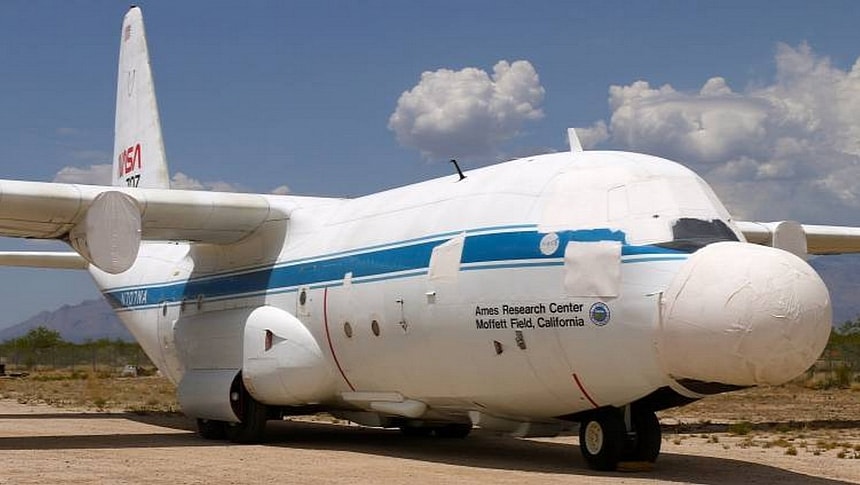You can't fly to low-Earth orbit on a government-surplus Space Shuttle Atlantis. But what you can do, if you're wealthy and fortunate enough and wealthy enough, you might be able to buy some genuine NASA surplus equipment. This could be anything from laptops with all their boot drives removed, some old simulation equipment, or a whole gosh darn aircraft.
This is the case with this 64-year-old Lockheed C-130H Hercules. It's not a Lockheed Martin C-130, but a Lockheed C-130. That's how old this dinosaur is. But over the course of its long and fruitful career, this quad-engine cargo plane built the same as its thousands of brethren, had a cooler assignment than perhaps any other in the fleet. It wasn't mortars, small jeeps, and artillery pieces that this Herc was flying around—more like sensitive and expensive scientific equipment for NASA.
For decades, this C-130 traveled the globe for NASA's Ames Research Center in Califonia, photographing as many swaths of the planet's landmass as part of their Earth Survey program. Using a wide array of cameras, sensors, and imaging equipment across a range of wavelengths and sensitivities to determine what kind of changes were occurring over these regions from a geological as well as a floristic perspective.
Through observing positive or negative deltas in geological activity and the proliferation of native vegetation versus newly-found invasive species, scientists can achieve a better understanding of what factors increase or decrease the prominence of features in the terrain. This kind of work doesn't lend to being used like a commercial pickup truck the way other C-130s across the globe regularly do. So to speak, this NASA veteran is in remarkable condition, considering its age and the theoretical limit of its endurance in a proper wartime setting.
At some point around 1995, budget cuts affecting NASA's bottom line under the administration of Bill Clinton lessoned the agency's ability to operate the aircraft and was placed into mothball status in long-term storage until the day came when it could be brought back to service cost-effectively. Sadly, that day never came, and the aircraft now finds itself under the ownership of a consortium called Lionheart International, and based in Houston, Texas, not far from NASA's Johnson Space Center.
Having never landed rough on an unpaved surface like so many C-130s, this Hercules is in much the same condition as it was the day it was mothballed. Its T56-A-15LFE turboprop engine should theoretically be flight-capable with a bit of prep time, once you re-attach them of course. In short, it might just be the cleanest pre-Lockheed Martin C-130 Hercules left on the planet. The amazing flight assignments attributed to its name are just added gravy on top. Check out the link here to learn more.
For decades, this C-130 traveled the globe for NASA's Ames Research Center in Califonia, photographing as many swaths of the planet's landmass as part of their Earth Survey program. Using a wide array of cameras, sensors, and imaging equipment across a range of wavelengths and sensitivities to determine what kind of changes were occurring over these regions from a geological as well as a floristic perspective.
Through observing positive or negative deltas in geological activity and the proliferation of native vegetation versus newly-found invasive species, scientists can achieve a better understanding of what factors increase or decrease the prominence of features in the terrain. This kind of work doesn't lend to being used like a commercial pickup truck the way other C-130s across the globe regularly do. So to speak, this NASA veteran is in remarkable condition, considering its age and the theoretical limit of its endurance in a proper wartime setting.
At some point around 1995, budget cuts affecting NASA's bottom line under the administration of Bill Clinton lessoned the agency's ability to operate the aircraft and was placed into mothball status in long-term storage until the day came when it could be brought back to service cost-effectively. Sadly, that day never came, and the aircraft now finds itself under the ownership of a consortium called Lionheart International, and based in Houston, Texas, not far from NASA's Johnson Space Center.
Having never landed rough on an unpaved surface like so many C-130s, this Hercules is in much the same condition as it was the day it was mothballed. Its T56-A-15LFE turboprop engine should theoretically be flight-capable with a bit of prep time, once you re-attach them of course. In short, it might just be the cleanest pre-Lockheed Martin C-130 Hercules left on the planet. The amazing flight assignments attributed to its name are just added gravy on top. Check out the link here to learn more.








